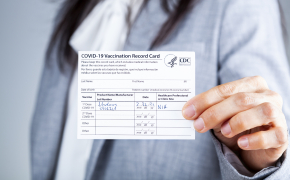New OSHA ETS Requires Two-Thirds of Private Employers to Mandate COVID-19 Vaccination or Require Regular Testing
The U.S. Occupational Safety and Health Administration (OSHA) has issued a new emergency temporary standard (ETS) that requires employers with 100 or more employees to mandate that all employees be vaccinated against COVID-19 or else undergo weekly testing. The ETS is effective immediately and requires compliance with all provisions except the testing provisions by December 6, 2021. Beginning on January 4, 2022, workers must be fully vaccinated or submit to testing.
Key Takeaways
- OSHA’s new ETS applies to employers with 100 or more employees company-wide and affects two-thirds of private employers and more than 84 million workers.
- According to OSHA, the ETS “is intended to establish minimum vaccination, vaccination verification, face covering, and testing requirements to address the grave danger of COVID-19 in the workplace, and to preempt inconsistent state and local requirements relating to these issues, including requirements that ban or limit employers’ authority to require vaccination, face covering, or testing.”
- Under the new ETS, employers must establish, implement, and enforce either a written mandatory COVID-19 vaccination policy or a written policy that allows employees to choose to be fully vaccinated or provide proof of regular testing for COVID-19 and wear a face covering.
- Compliance with all requirements except the testing requirements is required by December 6, 2021. Employees who have not received all of their primary vaccination doses by January 4, 2022 will be subject to regular testing at that time.
- While small employers are not subject to the ETS, OSHA is giving further consideration as to whether to adopt requirements for those employers.
- Employers should act now to review their current policies against the ETS, make necessary changes to come into compliance, and submit any comments to OSHA.
Background
Section 6(c) of the Occupational Safety and Health Act of 1970 gives OSHA authority to adopt an ETS without notice-and-comment rulemaking if OSHA “determines (A) that employees are exposed to grave danger from exposure to substances or agents determined to be toxic or harmful or from new hazards, and (B) that such emergency standard is necessary to protect employees from such danger.” An ETS adopted under section 6(c) is effective until superseded by a permanent standard. OSHA must adopt a permanent standard to replace the ETS within six months of publication of the ETS.
Prior to the COVID-19 Pandemic, OSHA had promulgated nine ETSs, with the last of those being promulgated in 1983. Those ETSs did not fare well in court challenges, and five were stayed or vacated, at least in part.
Under the Trump Administration, OSHA addressed the hazards associated with COVID-19 by relying on existing OSHA standards, the OSH Act General Duty Clause, and numerous guidance documents. During that administration, OSHA denied a petition asking it to adopt an ETS for COVID-19 prevention, and the D.C. Circuit denied a petition asking for a mandamus order to direct OSHA to adopt an ETS. See In re: AFL-CIO, No. 20-1158 (D.C. Cir. June 11, 2020).
The day after his inauguration, President Biden issued an executive order, “Protecting Worker Health and Safety,” directing OSHA to issue updated guidance to employers on workplace safety during the COVID-19 pandemic and to consider whether to issue a COVID-19 ETS and, if so, to issue it by March 15, 2021. E.O. 13999 of Jan. 21, 2021, 86 Fed. Reg. 7211 (Jan. 26, 2021). OSHA missed that deadline, in part because it was considering whether section 6(c)’s “grave danger” and “necessary” elements could be met with increasing vaccinations and declining infection rates at that time. OSHA determined that a COVID-19 ETS was necessary for just the healthcare sector, and issued that ETS on June 21, 2021. Our prior alert regarding the Healthcare ETS is available here.
On September 9, 2021, as new variants were on the rise and vaccine skepticism remained prevalent, President Biden issued a new COVID-19 Action Plan, effectively reversing OSHA’s decision to limit applicability of the ETS to the healthcare sector, and directing OSHA to adopt a broadly applicable ETS requiring full vaccination or testing. Our prior alert regarding President Biden’s September 9 announcement is available here. OSHA developed a new ETS in the weeks that followed, submitted the ETS to the White House Office of Management and Budget on October 12, 2021, and released the text of the ETS to the public on November 4, 2021. The ETS was published in the Federal Register today, and is effective immediately.
Key Requirements
The new ETS is set forth in 29 C.F.R. §1910.501. It is located in Subpart U of 29 C.F.R. Part 1910, along with the Healthcare ETS (29 CFR §1910.502).
The new ETS applies to employers with 100 or more employees company-wide at any time the ETS is in effect, including minors and temporary and seasonal workers, with two exceptions. The ETS does not apply to workplaces that are covered under the Safer Federal Workforce Task Force COVID-19 Workplace Safety: Guidance for Federal Contractors and Subcontractors or to settings that are covered under the Healthcare ETS. Additionally, the requirements of the new ETS do not apply to employees of covered employers who do not report to a workplace where other individuals are present, who work from home, or who work exclusively outdoors.
When employers are determining whether they meet the 100-employee threshold for coverage under the ETS, they must count all employees across all of their U.S. workplaces, regardless of where the employees perform their work, even if the majority of employees work exclusively from their homes. Employers should not count independent contractors or employees supplied by a staffing agency towards their total number of employees for determining coverage. If an employer has 100 or more employees as of November 5, 2021, it will continue to be covered by the ETS for the entire duration of the ETS, even if the size of its workforce drops below 100. Similarly, once an employer comes within the scope of the ETS, the ETS continues to apply for the remainder of the time the ETS is in effect, regardless of fluctuations in the size of its workforce.
The key requirements of the ETS are as follows.
- Mandatory Vaccination or Testing Policies: Covered employers must establish, implement, and enforce a mandatory written vaccination policy, unless exempt. The policy must require vaccination of all employees, other than those employees who fall into one of three categories: those for whom a vaccine is medically contraindicated, those for whom medical necessity requires a delay in vaccination, or those who are legally entitled to a reasonable accommodation under federal civil rights laws because they have a disability or sincerely held religious beliefs, practices, or observances that conflict with the vaccination requirement. An employer is exempt from the requirement to have a mandatory vaccination policy if the employer establishes, implements, and enforces a policy allowing employees to choose to be fully vaccinated against COVID-19 or provide proof of regular testing for COVID-19 and wear a face covering.
- Definition of “Fully Vaccinated”: Fully vaccinated means two weeks after the employee has completed their primary vaccination with a COVID-19 vaccine approved or authorized for emergency use by the FDA, listed for emergency use by the World Health Organization, or administered as part of a clinical trial at a U.S. site so long as certain conditions are met. Booster shots and additional doses are not included in the definition of fully vaccinated under the ETS at this time.
- Determination of Vaccination Status: Covered employers must determine the vaccination status of each employee, require each vaccinated employee to provide acceptable proof, and maintain those records and a roster of each employee’s vaccination status in accordance with 29 C.F.R. §1910.1020 for the duration of the ETS. Acceptable proof includes:
- Record of immunization from a health care provider or pharmacy;
- Copy of the COVID-19 vaccination record card;
- Copy of medical records documenting the vaccination;
- Copy of immunization records from an immunization information system;
- Copy of any other official documentation that contains the type of vaccine, date(s) of administration, and health care professional(s) or clinic site(s) administering the vaccine; or
- Signed and dated attestation using language set forth in the ETS; this form of proof is only acceptable where employee has lost or is otherwise unable to produce other acceptable proof.
If an employer determined vaccination status prior to November 5, 2021 through another form of proof or attestation and retained those records, the employer is not required to make a new determination, but is still required to create a roster and maintain proof of vaccination.
- Employer Support for Employee Vaccination: Covered employers must provide a reasonable amount of time to each employee for each of their primary vaccination series dose(s), including up to 4 hours of paid time. Covered employers must also provide reasonable time and paid sick leave for employees to recover from any side effects experienced following each primary vaccination series dose.
- COVID-19 Testing for Employees who are not Fully Vaccinated: Employees who are not fully vaccinated must be tested at least once every 7 days and provide documentation of the test result no later than the seventh day following the date of the last result. If an employee does not report to a workplace during a period of 7 or more days, the employee must be tested within 7 days prior to returning to the workplace and provide documentation of the result before or upon returning to the workplace. Employers are not required under the ETS to pay for any costs associated with testing, but must maintain a record of all tests in accordance with 29 C.F.R. §1910.1020 while the ETS remains in effect. To satisfy this requirement, the test must be an FDA-approved viral test that is administered in accordance with the authorized instructions and is not both self-administered and self-read unless observed by the employer or an authorized telehealth proctor. Both nucleic acid amplification tests (NAATs), such as a PCR test, and antigen tests (including over-the-counter antigen tests) are acceptable so long as they meet these requirements. Pool testing may be used to comply with the ETS.
- When an employee has received a positive COVID-19 test or has been diagnosed with COVID-19 by a licensed health care provider, the employer must not require that employee to undergo COVID-19 testing for 90 days following the date of their positive test or diagnosis, due to the high likelihood of false positive results reflecting past infection.
- Employee Notification to Employer of a Positive COVID-19 Test and Removal: Covered employers must require employees to promptly notify the employer when they receive a positive COVID-19 test or are diagnosed with COVID-19 by a licensed healthcare provider, and must immediately remove those employees from the workplace. An employee who has been removed from the workplace can return only if the employee receives a negative result on a confirmatory NAAT test (such as a PCR test) following a positive result on an antigen test, meets the return to work criteria in the CDC’s “Isolation Guidance”, or receives a recommendation to return to work from a licensed healthcare provider. The ETS does not require employers to provide paid time to employees who have been removed for a positive COVID-19 test or diagnosis.
- Face Coverings: Covered employers must ensure that each employee who is not fully vaccinated wears a face covering when indoors and when occupying a vehicle with another person, with limited exceptions (such as when alone in a fully enclosed room with a closed door). In addition, employers must not prevent employees, customers, or visitors from wearing face coverings. Further, employers must not prevent employees from wearing a respirator instead of a face covering. If employers provide employers with respirators, they must comply with the mini respiratory protection program requirements in 29 C.F.R. § 1910.504. The ETS does not require employers to pay for costs associated with face coverings.
- Employee Information: Covered employers must inform each employee about the requirements of the ETS; the employer’s policies and procedures to implement the ETS; COVID-19 vaccine efficacy, safety, and benefits (by providing CDC’s “Key Things to Know”); OSHA’s anti-retaliation provisions; and the provisions of 18 U.S.C. § 1011 and section 17(g) of the OSH Act, which provide for criminal penalties associated with knowingly supplying false statements or documentation.
- Reporting COVID-19 Fatalities and Hospitalizations: Covered employers must report each work-related COVID-19 fatality within 8 hours of learning of the fatality, and report each work-related COVID-19 in-patient hospitalization within 24 hours of learning of the hospitalization. Employers must follow the reporting requirements in 29 C.F.R. § 1910.39, except there is no limitation based on length of time between the exposure to COVID-19 in the workplace and the death or in-patient hospitalization.
- Availability of Records: Covered employers must make various records available to their employees, their representatives, and OSHA at set time frames. Employers must also make the aggregate number of fully vaccinated employees at a workplace and the total number of employees at that workplace available to employees, their representatives, and OSHA upon request.
As noted above, the ETS is effective immediately. Covered employers must comply with all requirements except the testing requirements by December 6, 2021. Beginning on January 4, 2022, workers must be fully vaccinated or submit to testing.
State Plans
Twenty-one states and Puerto Rico have state plans covering private employers, meaning that federal OSHA standards do not apply there. They will have to adopt their own ETSs on vaccination and testing. Those state ETSs must be at least as effective in providing safe and healthful employment and places of employment as the OSHA ETS, but need not be identical. State-plan jurisdictions must adopt an ETS within 30 days of publication of the OSHA ETS, to remain in effect for the duration of the OSHA ETS, unless they already have a standard that is at least as effective. 29 C.F.R. § 1953.5(b)(1).
Anticipated Legal Challenges
The ETS is highly likely to be challenged by various states, employers, and/or trade associations. For instance, Arizona has already filed a lawsuit against the Biden Administration regarding this ETS and the vaccine mandates for federal workers and contractors. In addition, several states have announced their intention to challenge the ETS in court. Challenges to the ETS will likely focus on whether OSHA has established the “grave danger” and “necessary” elements for the ETS, federalism concerns, and questions about infringement on individual citizens’ constitutional rights.
What to Do Now
Employers should act now to review their current COVID-19 policies and determine whether they need to be modified to come into compliance with the ETS. Among the considerations employers should address are:
- Whether the ETS applies to their workplaces;
- Whether they will adopt a mandatory vaccination policy or adopt a policy that provides employees with the choice of vaccination or regular testing and the use of face coverings;
- Whether to sponsor on-site vaccination clinics;
- How to provide paid time off for vaccination and recovery;
- How they will structure their testing program;
- Procedures for notification of employee COVID-19 cases, removal, and return to work;
- Procedures for reporting COVID-19 related hospitalizations and fatalities;
- How to provide requisite information to employees; and
- How they will maintain the records required under the ETS and make them available when required.
In addition, employers have until December 6, 2021 to submit comments on any aspect of the ETS and whether the ETS should be a final rule. OSHA is particularly interested in receiving comments on topics described in its fact sheet OSHA’s Vaccination and Testing ETS: How You Can Participate. OSHA intends to review comments in considering next steps.
OSHA has developed multiple fact sheets and compliance assistance materials to help employers comply with this ETS, including model policies, as well as a lengthy list of FAQs. See here.
Employers should continue to consider OSHA’s guidance (updated August 13, 2021) on other aspects of protecting workers from COVID-19. That guidance, and relevant CDC guidance, is summarized in a previous alert. As applicable, employers should also consider the September 9, 2021 Executive Order on Ensuring Adequate COVID Safety Protocols for Federal Contractors and the Safer Federal Workforce Task Force COVID-19 Workplace Safety: Guidance for Federal Contractors and Subcontractors.
On Wednesday, November 17, the authors of this alert will present a webinar discussion of the new OSHA COVID-19 vaccination and testing ETS, including who is covered, what is required, what options employers have, and litigation challenges. Please click here for more information.
Beveridge & Diamond’s Occupational Safety & Health practice group works alongside clients’ legal, EHS, and technical teams to help resolve critical enforcement, compliance, and regulatory issues relating to their facilities and operations. We maintain an Occupational Safety & Health Resource Center designed to help companies understand the regulatory framework for worker health and safety protection and stay educated about the federal and state developments affecting their workplaces. We also maintain a COVID-19 EH&S Resource Center to help companies navigate the pandemic, protect their employees, and minimize business interruptions. For more information, please contact the authors.












